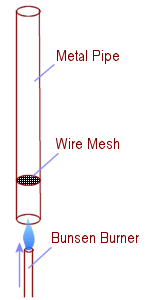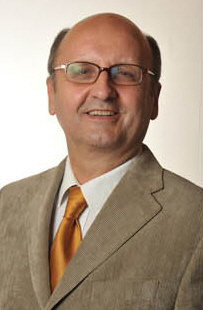Related Research Articles

The Rijke tube is a cylindrical tube with both ends open, inside of which a heat source is placed that turns heat into sound, by creating a self-amplifying standing wave. It is an entertaining phenomenon in acoustics and is an excellent example of resonance.

Active vibration control is the active application of force in an equal and opposite fashion to the forces imposed by external vibration. With this application, a precision industrial process can be maintained on a platform essentially vibration-free.
The brown note, also sometimes called the brown frequency or brown noise, is a hypothetical infrasonic frequency capable of causing fecal incontinence by creating acoustic resonance in the human bowel. Considered an urban myth, the name is a metonym for the common color of human faeces. Attempts to demonstrate the existence of a "brown note" using sound waves transmitted through the air have failed.
Hysteresivity derives from “hysteresis”, meaning “lag”. It is the tendency to react slowly to an outside force, or to not return completely to its original state. Whereas the area within a hysteresis loop represents energy dissipated to heat and is an extensive quantity with units of energy, the hysteresivity represents the fraction of the elastic energy that is lost to heat, and is an intensive property that is dimensionless.

Fluid–structure interaction (FSI) is the interaction of some movable or deformable structure with an internal or surrounding fluid flow. Fluid–structure interactions can be stable or oscillatory. In oscillatory interactions, the strain induced in the solid structure causes it to move such that the source of strain is reduced, and the structure returns to its former state only for the process to repeat.

Roddam Narasimha FRS was an Indian aerospace scientist and fluid dynamicist. He was a professor of Aerospace Engineering at the Indian Institute of Science (1962–1999), director of the National Aerospace Laboratories (1984–1993) and the chairman of the Engineering Mechanics Unit at Jawaharlal Nehru Centre for Advanced Scientific Research. He was the DST Year-of-Science Chair Professor at JNCASR and concurrently held the Pratt & Whitney Chair in Science and Engineering at the University of Hyderabad. Narasimha was awarded the Padma Vibhushan, India's second-highest civilian award, in 2013. for his contributions to advance India's aerospace technology.

In fluid dynamics, slosh refers to the movement of liquid inside another object.
Maurice Bertram Priestley was a professor of statistics in the School of Mathematics, University of Manchester. He gained his first degree at the University of Cambridge and went on to gain a Ph.D. from the University of Manchester.
Ali Hasan Nayfeh was a Palestinian-Jordanian mathematician, mechanical engineer and physicist. He is regarded as the most influential scholar and scientist in the area of applied nonlinear dynamics in mechanics and engineering. He was the inaugural winner of the Thomas K. Caughey Dynamics Award, and was awarded the Benjamin Franklin Medal in mechanical engineering. His pioneering work in nonlinear dynamics has been influential in the construction and maintenance of machines and structures that are common in daily life, such as ships, cranes, bridges, buildings, skyscrapers, jet engines, rocket engines, aircraft and spacecraft.

John Dylan Morgan was a Welsh mathematician, physicist, hypnotherapist and author. He developed a theoretical approach to hypnotherapy which he published in his book Principles of Hypnotherapy. He also made contributions in theoretical and applied physics.

Marco Amabili is a professor who holds the Canada Research Chair in Vibrations and Fluid-Structure Interaction, Department of Mechanical Engineering at McGill University, Montreal, Québec, Canada.

Rail squeal is a screeching train-track friction sound, commonly occurring on sharp curves.

Dimitris Drikakis, PhD, FRAeS, CEng, is a Greek-British applied scientist, engineer and university professor. His research is multidisciplinary. It covers fluid dynamics, computational fluid dynamics, acoustics, heat transfer, computational science from molecular to macro scale, materials, machine learning, and emerging technologies. He has applied his research to diverse fields such as Aerospace & Defence, Biomedical, and Energy and Environment Sectors. He received The William Penney Fellowship Award by the Atomic Weapons Establishment to recognise his contributions to compressible fluid dynamics. He was also the winner of NEF's Innovator of the Year Award by the UK's Institute of Innovation and Knowledge Exchange for a new generation carbon capture nanotechnology that uses carbon nanotubes for filtering out carbon dioxide and other gases.
Dynamical energy analysis (DEA) is a method for numerically modelling structure borne sound and vibration in complex structures. It is applicable in the mid-to-high frequency range and is in this regime computational more efficient than traditional deterministic approaches (such as finite element and boundary element methods). In comparison to conventional statistical approaches such as statistical energy analysis (SEA), DEA provides more structural details and is less problematic with respect to subsystem division. The DEA method predicts the flow of vibrational wave energy across complex structures in terms of (linear) transport equations. These equations are then discretized and solved on meshes.
A whistle is a device that makes sound from air blown from one end forced through a small opening at the opposite end. They are shaped in a way that allows air to oscillate inside of a chamber in an unstable way. The physical theory of the sound-making process is an example of the application of fluid dynamics or hydrodynamics and aerodynamics. The principles relevant to whistle operation also have applications in other areas, such as fluid flow measurement.

Kevin C. A. Burke was a geologist known for his contributions in the theory of plate tectonics. In the course of his life, Burke held multiple professorships, most recent of which (1983-2018) was the position of professor of geology and tectonics at the Department of Earth and Atmospheric Science, University of Houston. His studies on plate tectonics, deep mantle processes, sedimentology, erosion, soil formation and other topics extended over several decades and influenced multiple generations of geologists and geophysicists around the world.
Charles Laurie Dolph was an American mathematician known for his research in applied mathematics and engineering.
Amitabha Ghosh is an Indian researcher, administrator and educator. He currently holds the position of Honorary Scientist, Indian National Science Academy and Honorary Distinguished Professor in the Aerospace Engineering and Applied Mechanics Department at the Indian Institute of Engineering Science and Technology, Shibpur, Howrah, West Bengal. He is an Emeritus Senior Fellow of the Alexander von Humboldt Foundation and a Fellow of The National Academy of Sciences, India, of which he was elected a Senior Scientist Platinum Jubilee Fellow in 2012. Ghosh has made contributions in various fields, including fundamental and applied research, technology development, administration and social development.
Eleni Chatzi is a Greek civil engineer, researcher, and an associate professor and Chair of Structural Mechanics and Monitoring at the Department of Civil, Environmental and Geomatic Engineering of the Swiss Federal Institute of Technology in Zurich.

Critical embankment velocity or critical speed, in transportation engineering, is the velocity value of the upper moving vehicle that causes the severe vibration of the embankment and the nearby ground. This concept and the prediction method was put forward by scholars in civil engineering communities before 1980 and stressed and exhaustively studied by Krylov in 1994 based on the Green function method and predicted more accurately using other methods in the following. When the vehicles such as high-speed trains or airplanes move approaching or beyond this critical velocity, the vibration magnitudes of vehicles and nearby ground increase rapidly and possibly lead to the damage to the passengers and the neighboring residents. This relevant unexpected phenomenon is called the ground vibration boom from 1997 when it was observed in Sweden for the first time.
References
- 1 2 Noor, A. K. (June 2003), "Arthur Leissa—a biographical sketch", Journal of Sound and Vibration, 263 (5): 963–964, Bibcode:2003JSV...263..963N, doi:10.1016/s0022-460x(03)00267-0